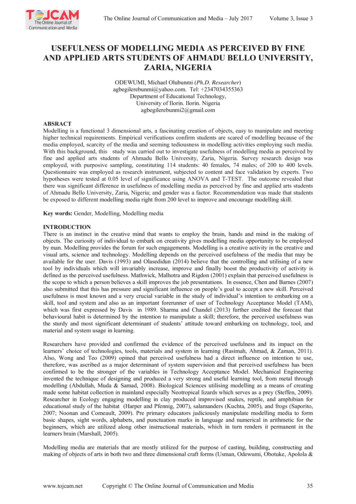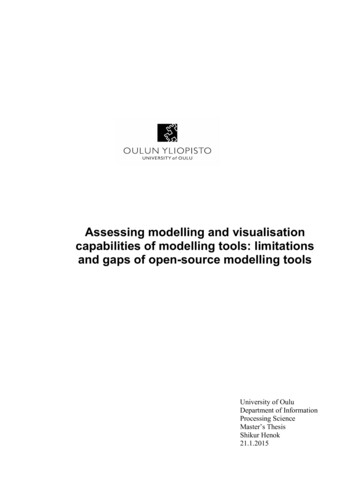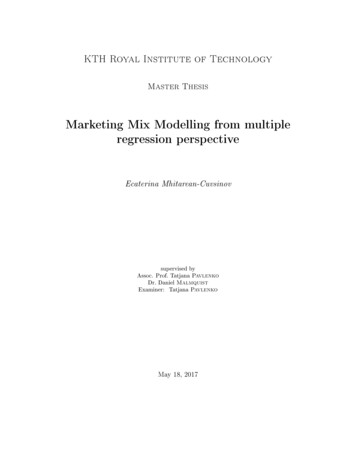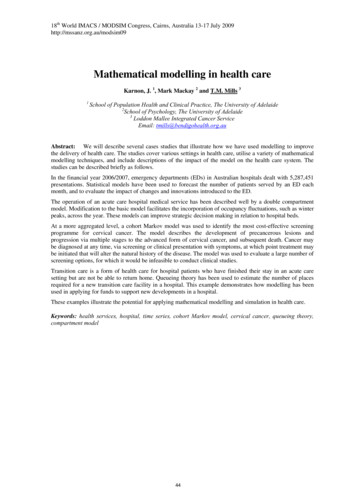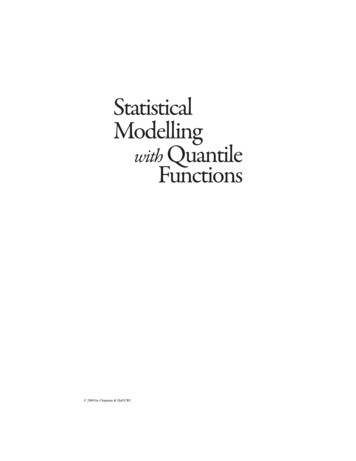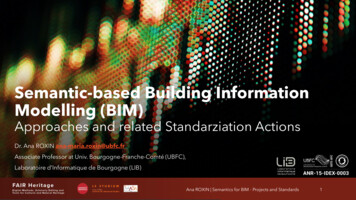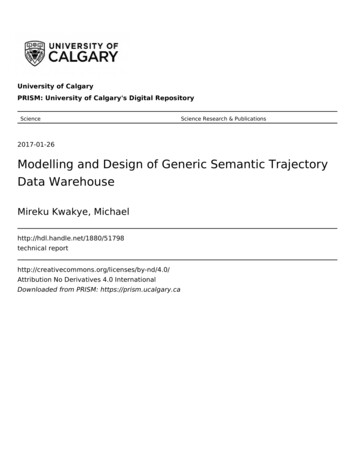
Transcription
University of CalgaryPRISM: University of Calgary's Digital RepositoryScienceScience Research & Publications2017-01-26Modelling and Design of Generic Semantic TrajectoryData WarehouseMireku Kwakye, Michaelhttp://hdl.handle.net/1880/51798technical 0/Attribution No Derivatives 4.0 InternationalDownloaded from PRISM: https://prism.ucalgary.ca
UNIVERSITY OF CALGARYMODELLING AND DESIGN OF GENERICSEMANTIC TRAJECTORY DATA WAREHOUSEbyMICHAEL MIREKU KWAKYETECHNICAL REPORT: 2017-001-01DEPARTMENT OF COMPUTER SCIENCECALGARY, ALBERTAJANUARY, 2017 Michael Mireku Kwakye 2017
Michael Mireku Kwakye - Technical Report:2017-001-01 - January 2017AbstractThe trajectory patterns of a moving object in a spatio-temporal domain offers variedinformation in terms of the management of the data generated from the movement. Atrajectory data warehouse is a data repository for the data and information oftrajectory objects and their associated spatial objects for defined temporal periods.The query results of trajectory objects from the data warehouse are usually notenough to answer certain trend behaviours and meaningful inferences without theassociated semantic information of the trajectory object or the geospatial environmentwithin a specified purpose or context. In this report, I formulate and design a genericontology modelling framework that serves as the background model platform for thedesign of a semantic data warehouse for trajectories. This semantic trajectory datawarehouse can be adaptable for trajectory data processing and analytics on anychosen spatio-temporal application domain. The methodology underpins on highergranularity of data as a result of pre-processed and transformed ETL data so as tooffer efficient semantic inference to the underlying trajectory data. Moreover, theapproach outlines the thematic dimensions that serve as necessary entities forextracting semantic information. Additionally, the modelling approach offers a designplatform for effective predictive trend analysis and knowledge discovery in thetrajectory dynamics and data processing for moving objects.Keywords: Semantic Trajectory Data Warehouse, Generic TrajectoryOntology, Semantic Annotations, Spatio-Temporal Data Modelling,Multidimensional Entity RelationshipModelling and Design of Generic Semantic Trajectory Data Warehouseii
Michael Mireku Kwakye - Technical Report:2017-001-01 - January 2017Table of Contents12Introduction . 11.1Problem Summary . 11.2Motivation and Research Objective . 21.3Research Goals and Assumptions . 21.4Research Contributions. 21.5Report Outline . 3Background Literature Review on Trajectory Data Warehouses . 42.1Trajectories and Data Warehouses. 42.2Trajectories and Ontologies . 42.3Recent Approaches and Notable Propositions . 52.3.1SWOT: Conceptual Data Warehouse Model for SemanticTrajectories . 52.3.2Ontology-Based Trajectory Data Warehouse Conceptual Model. 52.3.3Research Gaps. 52.43Summary . 6Trajectory Analysis, Semantics and Data Warehousing. 73.1Trajectory Analysis . 73.2Semantic Enrichment for Trajectories . 83.3Trajectory Data Warehousing . 83.4Summary . 94 Generic Semantic Trajectory Data Warehouse – Thematic ModellingConstructs . 1054.1Geographical Space Dimension . 114.2Temporal Instance Dimension . 124.3Events Representation Dimension. 134.4Trajectory Representation Dimension . 154.5Social Interaction Dimension . 184.6Summary . 19Experimental Implementation Approach & Details . 205.1Semantic Web Ontology Modelling . 205.2Extract-Transform-Load (ETL) Procedures . 225.3Physical Design of Semantic Trajectory Data Warehouse . 225.4Summary . 23Modelling and Design of Generic Semantic Trajectory Data Warehouseiii
Michael Mireku Kwakye - Technical Report:2017-001-01 - January 20176Research Outcomes & Evaluation. 246.16.1.1Tourist Movement and Tourism Management . 246.1.2Birds Migration and Ecology . 256.1.3Highway Traffic and Transportation Management. 256.27Expected Answerable Queries . 24Summary . 26Comparison & Performance Analysis to Other Approaches. 277.1Discussions on Qualitative Comparative Analysis and PerformanceMeasures . 287.28Summary . 29Application Domains of Semantic Trajectory Data Warehouse . 308.1Birds Migration and Ecology . 308.2Tourist Movement and Tourism Management . 308.3Highway Traffic and Transportation Management . 318.4Comparative Analysis of the Trajectory Dynamics for ApplicationDomains . 318.59Summary . 32Conclusion, Open Issues and Future Work . 33Bibliography . 34Appendix . 36A: Query Syntaxes . 36Modelling and Design of Generic Semantic Trajectory Data Warehouseiv
Michael Mireku Kwakye - Technical Report:2017-001-01 - January 2017List of TablesTable 1. Qualitative Methodology Comparative Analysis and PerformanceMeasurements ---------------------------- 27Table 2. Comparative Analysis of Application Domain Trajectory Dynamics 32Modelling and Design of Generic Semantic Trajectory Data Warehousev
Michael Mireku Kwakye - Technical Report:2017-001-01 - January 2017List of Figures and IllustrationsFigure 1.An Illustration of a Raw Trajectory ----------------------------------- 7Figure 2.Conceptual Semantic Trajectory Data Warehouse Model ---- 10Figure 3.Taxonomy Model of the Geographical Space Dimension ----- 11Figure 4.ModelCharacteristic Description of Geographical Space Taxonomy12Figure 5.Taxonomy Model of the Temporal Instance Dimension ------ 13Figure 6.Taxonomy Model of the Events Representation Dimension - 14Figure 7.Characteristic Description of the Events RepresentationTaxonomy Model ------------------------- 14Figure 8.A Diagrammatic Illustration of a Semantic Trajectory [2]----- 15Figure 9.Taxonomy Model of the Trajectory Representation Dimension15Figure 10.Characteristic Description of Trajectory RepresentationTaxonomy Model (a) --------------------- 16Figure 11.Characteristic Description of Trajectory RepresentationTaxonomy Model (b) --------------------- 17Figure 12.Taxonomy Model of the Social Interaction Dimension -------- 17Figure 13.ModelCharacteristic Description of the Social Interaction Taxonomy18Figure 14.DWWeb Ontology Language Modelling of the Semantic Trajectory20Figure 15. OWL Modelling of the Semantic Trajectory DW – Fact Attribute &Measures21Figure 16. Snapshot of OWL Modelling of the Semantic Trajectory DW –Dimensions 21Figure 17. A Diagrammatic Illustration for the Schema Design of theSemantic Trajectory Data Warehouse ------------------------------------------------- 23Modelling and Design of Generic Semantic Trajectory Data Warehousevi
Michael Mireku Kwakye - Technical Report:2017-001-01 - January 2017List of AbbreviationsDWData ncy IdentificationGPSGlobal Positioning SystemsGISGeographical Information SystemPOIPoint of InterestROIRegion of InterestEOIEvent of InterestDOGMADeveloping Ontology-Grounded Methods and ApplicationsOBMODOntology-Based Moving Object DataMERMultidimensional Entity RelationshipSWOTSemantic Data Warehouse of TrajectoriesOWLWeb Ontology LanguageDBDatabaseDBMSDatabase Management SystemEREntity RelationshipModelling and Design of Generic Semantic Trajectory Data Warehousevii
Michael Mireku Kwakye - Technical Report:2017-001-01 - January 20171IntroductionThe trajectory of an object is the sequence of ordered-points of a path or route followed bythe moving object in a defined geographical space, and mostly within a specified temporalfunction. Objects could be classified as humans, animals, or vehicles within a geographiccontext. The trajectories of these objects could be affected or informed by varied factors,such as, weather changes (for example, wind resistance, rain precipitation, and snow falls),gravity, geographic surfaces, and events, amongst others.Over the years the tracking of the trajectory movement of these objects has been donewith the aid of devices, such as, Global Positioning Systems (GPSs), smart phones, geosensors, surveillance cameras, and Radio-Frequency Identification (RFID) tags, amongstothers. The trajectory data capture by these devices and the subsequent processing byGeographical Information Systems (GIS) have increased the amount of movement data forfuture trend analysis [15, pp. 2]. Moreover, recent application of satellite devices has beenadopted in capturing the trajectory of moving objects, as has been in the case of vehicularmovements [16].The concept of trajectories has received quite an appreciable amount of study in theliterature. These studies have gain much attention because of the traditional spatial andtemporal applications in the fields of GIS. The information gathered from specifictrajectories has become useful in varied application domains. The collected data arevaluable in the detection of informed and uninformed trends in trajectory movements, andcritical in decision-making for these application domains, such as, tourism management,and animal migration, amongst others.A semantic trajectory data warehouse (DW) is a data repository that stores the semanticinformation of a trajectory object and the associated spatial objects within a period oftemporal instance to achieve a particular goal or purpose. In analyzing the semanticinformation of a trajectory object, the stop and move activity of the object at any temporalinstance is determined by the goal. This goal could be classified as being a personal goal,an activity object goal, or a movement objective, for the activity in view [2] [5]. Some ofthe semantic information are annotations of semantic objects, events and activities,behavioral data, and the data of the spatio-temporal objects, amongst others.In this report, I formulate a framework model for the modelling and design of asemantic data warehouse for a trajectory object in a spatio-temporal paradigm. The novelproposition is to gather all relevant semantic data of objects and events related to thetrajectory object, as well as, the trajectory object itself and its movement dynamics.Hence, the main contribution in this report is to present a generic modelling approach forthe design of semantic data warehouses for trajectories. To this end, I will focus on anapproach based on the higher granularity level of preprocessed and transformed trajectorydata, being an output of Extract-Transform-Load (ETL) procedures. It is my expectationthat this higher granularity level of trajectory data will offer an optimal medium forefficient query processing, and to accommodate the large volume of trajectory data feedsfrom raw sources.1.1 Problem SummaryThe data gathered from raw trajectory data from different application domains keeps risingand has become much more relevant because of the varied inferences that can be drawnfrom them. Much more is the need to find out and ascertain why some trajectory objectsbehave, move, or stop at specific areas and at specific times in their geospatialenvironment.Modelling and designing a trajectory data warehouse for analysis and predictiveinferences has been studied so far in the literature, and have been addressed by variedresearchers. On the other hand, the need to understand the rare semantics of trajectorystops, moves, velocity rates, and movement pattern, amongst others, still remains aModelling and Design of Generic Semantic Trajectory Data Warehouse1
Michael Mireku Kwakye - Technical Report:2017-001-01 - January 2017challenge. Additionally, the characteristic attributes of trajectory objects and the semanticannotations associated with events and activities that the objects participates in draw outvital information that most trajectory data warehouses are not able to address.1.2 Motivation and Research ObjectivePast research on trajectory data warehousing have focused on studying the modelling anddesign constructs for the warehouse structure. Some of the methodology approaches haveformulated ontologies to utilize them as the modelling framework constructs. Most ofthese methodology approaches do not outline a comprehensive generic ontology model forthe trajectory data warehouse, and the associated semantic annotations. Moreover, some ofthe approaches do not consider inferences that can be drawn from social mediainteractions of the trajectory object.In this report, I introduce a novel methodology approach that defines and outlines ageneric ontology model for handling the varied semantic characteristics of trajectoryobjects, events and activities, environmental considerations, as well as, social mediainteraction. This generic ontology model serves as the background platform for themodelling and design of the thematic constructs for a semantic trajectory data warehouse.The formulated semantic trajectory data warehouse offers a data repository platform fordetailed and enhanced fact attributes and numeric measures. Additionally, the soundgeneric ontology model enables the semantic trajectory data warehouse to offer descriptivedimensionality attribute representation for the unique characteristic of any chosenapplication domain.1.3 Research Goals and AssumptionsAs discussed earlier in the previous subsection, this research introduces a novel approachto deliver a generic semantic trajectory data warehouse. More specifically, I address ageneric semantic trajectory data warehouse that can be related to varied applicationdomains, even in the face of peculiar characteristic features. The merits of themethodology approach offers:a)An expressive generic ontology model for trajectory objects, geographicenvironments, events and activities, and social media interaction;b) A comprehensive trajectory data warehouse platform for efficient, scalable, andoptimized query processing;c) Maximum semantic annotation enrichment for every aspect of the trajectory of amoving object.A summary of some assumptions needed to validate this research is enumerated, asfollows: Firstly, the use of high granularity preprocessed ETL instance data are to beadopted for population into the designed semantic trajectory data warehouse. This isnecessary because of the highly-refined and aggregated data item elements in the fact ordimension repositories. Secondly, the processing of certain queries on the formulatedsemantic trajectory data warehouse. Certain query solutions are expected because of thedistinct definition of fact attribute measures and dimension attributes in the trajectory datawarehouse.1.4 Research ContributionsAs part of outlining the novel methodology for modelling and designing a genericsemantic trajectory data warehouse, I summarize and itemize the technical contributions;as follows: To formulate a generic ontology for the modelling of semantic trajectory of movingobjects which extends to different application domains;Modelling and Design of Generic Semantic Trajectory Data Warehouse2
Michael Mireku Kwakye - Technical Report:2017-001-01 - January 2017 To instantiate the constructs of the formulated generic ontologies to design asemantic data warehouse model for the trajectory data of moving objects; To outline the thematic dimensions, the fact information, and the attribute andmeasure data for the trajectory data warehouse; which will serve as data modellingentities for semantic trajectory of moving objects; To utilize the semantic data warehouse instances as a platform for the predictivetrend analysis and knowledge discovery of the trajectory of moving objects in aspatio-temporal application domain; such as, tourist movement and tourismmanagement, birds migration, and traffic management, amongst others.1.5 Report OutlineThe report is organized into nine chapters, as follows: In Chapter 2, I address and reviewthe background studies that have been conducted so far in the literature relating to spatiotemporal and trajectory data warehouse. Chapter 3 addresses an overview of thetrajectories, semantics, and semantic trajectory data warehouse which serves as amodelling design platform for predictive analysis and decision-making. I present thethematic object representation of the modelling design in Chapter 4, where I describe thedetailed modelling constructs and their semantic relevance. In Chapter 5, I discuss theexperimental implementation procedures of ontology modelling, ETL procedures, as wellas, design work of the trajectory data warehouse.In Chapter 6, I discuss a summary of the key outcomes arising out of this research;highlighting the generic ontology, thematic dimensions in the data warehouse, and onsome of the prime queries that can be posed to the semantic trajectory data warehouse.Chapter 7 discusses the comparative analysis and performance measurements of previousrelated work to the propositions in this research. Here, I address the merits of thepropositions of this research over the other methodology approaches. Chapter 8 discussessome the application domain areas of the research. I conclude in Chapter 9 and discuss themajor contributions, and also highlight on the open issues and future work in the area ofsemantic trajectory data warehouse modelling.Modelling and Design of Generic Semantic Trajectory Data Warehouse3
Michael Mireku Kwakye - Technical Report:2017-001-01 - January 20172Background Literature Review on Trajectory Data WarehousesA number of related studies have been investigated in the areas of spatio-temporal datawarehousing and trajectories. These studies in the literature tend to serve as knowledgebase for main contribution in this report, and offer a broad platform to present themodelling design. One of the earliest propositions of conceptual modeling of spatiotemporal applications was investigated by Parent et al. (2006) [6]. In their study, theauthors highlighted the data modelling from a multidimensional view where eachdimension is handled from an orthogonal theme of data structures, space, and timerepresentation, amongst others.2.1 Trajectories and Data WarehousesStudies on trajectory data warehouses (DWs) have been investigated by Orlando et al.(2007) [8], and Vaisman and Zimányi (2013) [12], with the latter being a more recentstudy. The work by Orlando et al. (2007) [8] investigated and addressed the challenges ofaggregations that are encountered as a result of building trajectory DWs. In theirassessment, the authors propose a methodology to outline the complex aggregate andsummarization computation of measure presence. Vaisman and Zimányi (2013) [12], onthe other hand, presented a textual description of the constituent dimensions of a datawarehouse for trajectories, where the authors discussed various mobility data analysis,varied temporal types, and instances of queries that could be posed to trajectory datawarehouses. Their work finally analyzed a typical instance of Northwind trajectory datawarehouse to support their conceptual proposition.Spaccapietra et al. (2008) [3], also in their study of the conceptual approach oftrajectories propose a modelling methodology. On one hand, their approach adopted a setof standard constructs that enriches the underlying spatio-temporal data model. On theother hand, customized constructs are adopted to offer maximum flexibility for specificsemantics of application-centered trajectories. The two approaches of modelling that werestipulated are based on data types and on design patterns. In presenting their proposition,the authors make mention of semantics of POIs object, but fail to give a detaileddescription and impact analysis of the semantics of these POIs object, the trajectory object,and also the movement dynamics of the trajectory object.2.2 Trajectories and OntologiesAn ontological approach for semantic representation of trajectories was investigated byBaglioni et al. (2009) [1]. The authors applied procedures of semantic enrichment oftrajectories by way of deducing reasoning from the trajectory patterns as a result of miningthe raw data feeds. This study brought to the fore a background knowledge on which theauthors in Campora et al. (2011) [4] presented a closer study of the modelling of datawarehouses for trajectories. The work by Campora et al. (2011) [4] leveraged on andcomplemented the other prior research work investigated in Marketos et al. (2008) [7] andSpaccapietra et al. (2008) [3]. Thus, Campora et al. (2011) [4] introduced formalmodelling constructs for high-level expression of the architecture and modelling oftrajectory data warehouses.Parent et al. (2013) [5] addressed the broad overview of data analysis of trajectories andmobility data management based on the studies done in the literature so far. In theirsurvey, the authors expounded on the approaches and techniques of trajectoryconstruction, the enrichment of semantic information on trajectories, and the application ofdata mining techniques to analyze and extract semantic knowledge from trajectorymovement.Modelling and Design of Generic Semantic Trajectory Data Warehouse4
Michael Mireku Kwakye - Technical Report:2017-001-01 - January 20172.3 Recent Approaches and Notable PropositionsRecent studies on the semantic modelling of trajectory data warehouses have beeninvestigated by Wagner et al. (2014) [9], Sakouhi et al. (2014) [10], Da Silva et al. (2015)[2] and Manaa and Akaichi (2016) [11].2.3.1 SWOT: Conceptual Data Warehouse Model for Semantic TrajectoriesMore specifically, the work by Da Silva et al. (2015) [2] presented a study on formulatinga conceptual and semantic data warehouse for trajectories where they proposed a modelthat relies on the DOGMA framework [13] and offers a dual modelling of ontologies. Thisproposition enables the separation of the ontology information into two conceptual datalayers. The ontologies are, namely; Consensual and Interpretation. Consequently, theauthors fail to address the addition of much enhanced numerical measures for the factrelationship and did not illustrate a generic ontology model which can be applicable todifferent domains.2.3.2 Ontology-Based Trajectory Data Warehouse Conceptual ModelIn the study by Manaa and Akaichi (2016) [11], the authors discussed the approach ofmodelling ontology data using Ontology-Based Moving Object Data (OBMOD); and theefficient ways of storing and querying heterogeneous OBMOD. In their methodology, theauthors defined an ontology-based design approach to model and analyze a globaltrajectory shared ontology and its associated semantics. Moreover, their approach definedthe structure of the conceptual model for a semantic trajectory data warehouse based on aformulated algorithm, but fail to outline practical query processing on the semantictrajectory data warehouse.2.3.3 Research GapsIn the review of the literatures, it can be inferred that though semantic trajectory datawarehouse has been studied so far, the proposition for a generic semantic trajectory datawarehouse model for varied application domains has not been yet addressedcomprehensively. Most importantly, the ability of the generic semantic trajectory datawarehouse to incorporate social media interaction of the trajectory object is stillunavailable.In this report, I attempt to leverage on the prior work by Da Silva et al. (2015) [2] andManaa and Akaichi (2016) [11], and propose a methodology that defines a completegeneric ontology framework. Here, this ontology framework will globally analyze atrajectory data and the associated semantics for the trajectory objects, the spatio-temporalobject dynamics, and the events representation in the trajectory movement. A novelcontribution to the proposed ontology design is to analyze the social media interaction of atrajectory object, such as, a tourist posts and comments as he or she travels in a trajectorypath. Additionally, the proposed methodology framework will define a formulatedmultidimensional star-schema model for the semantic trajectory data warehouse based onthe earlier proposed generic ontology framework.Moreover, a key contribution in this research is to deliver a data repository model thatis able to answer practical queries for semantic analysis of trajectory data based onenhanced numeric measures and descriptive dimension attributes. The proposition of themodelling and design of a trajectory data warehouse is based on the intuition of a higherlevel ETL-transformed trajectory data.Modelling and Design of Generic Semantic Trajectory Data Warehouse5
Michael Mireku Kwakye - Technical Report:2017-001-01 - January 20172.4 SummaryIn this Chapter, I discussed about the various studies that have been investigated in theareas of trajectories and the semantics annotations. More so, I highlighted on studiesregarding the modelling of trajectory data warehouses and the need to model ontologies tooffer generic approaches in modelling the trajectory data warehouses. I further expatiatedon two key methodology approaches to ontology modelling of semantic trajectory datawarehouses. I addressed the key propositions that this research offers as a merit over theprevious methodology approaches.In the next Chapter, I discuss and address the concept of trajectories, the semanticannotations that are associated with trajectory movements, and the modelling constructs offacts and dimensions for trajectory data warehouses.Modelling and Design of Generic Semantic Trajectory Data Warehouse6
Michael Mireku Kwakye - Technical Report:2017-001-01 - January 20173Trajectory Analysis, Semantics and Data WarehousingIn this Chapter, I discuss and explain the conceptual idea regarding trajectory andmobility, and the subsequent modelling of their constituent data for data warehousingpurposes. The trajectory of a moving object is usually focused on the path movement ofthe object and the relationship to the geographic locations that the object interacts with,and geometric properties like surface area, velocity, and direction change associated withthe movement.3.1 Trajectory AnalysisThe study of the trajectories involves the identification of stops and moves within the pathof the trajectory. A stop is a non-empty time interval of which the trajectory object doesnot move [3]. Each stop could be prompted or activated by the need or involvement in anactivity of the trajectory object at that specific temporal instance, and as well as, itsassociation to a geographic object. An example of a stop is a bird resting in a nest on amountain top. The move is a part of a trajectory representing a spatial range that isdelimited by two distinct stops. As a result, a move is a set of time-varying points definedfrom two consecutive stops, that is, {𝑇𝐵𝑒𝑔𝑖𝑛 , 𝑇𝐹𝑖𝑟𝑠𝑡𝑆𝑡𝑜𝑝 } or {𝑇𝐿𝑎𝑠𝑡𝑆𝑡𝑜𝑝 , 𝑇𝐸𝑛𝑑 } [3]. In context,the set of trajectory stops and moves together with the temporal instances, in the overallpath movement of an object generates a raw trajectory for the moving object.Definition 1. (Raw Trajectory): Let 𝐺 {𝑝1 , 𝑝2 , , 𝑝𝑛 } represent the arbitrary set ofnoticeable points in a geographical space, G
In this report, I formulate a framework model for the modelling and design of a semantic data warehouse for a trajectory object in a spatio-temporal paradigm. The novel proposition is to gather all relevant semantic data of objects and events related to the trajectory object, as well as, the trajectory object itself and its movement dynamics. .
